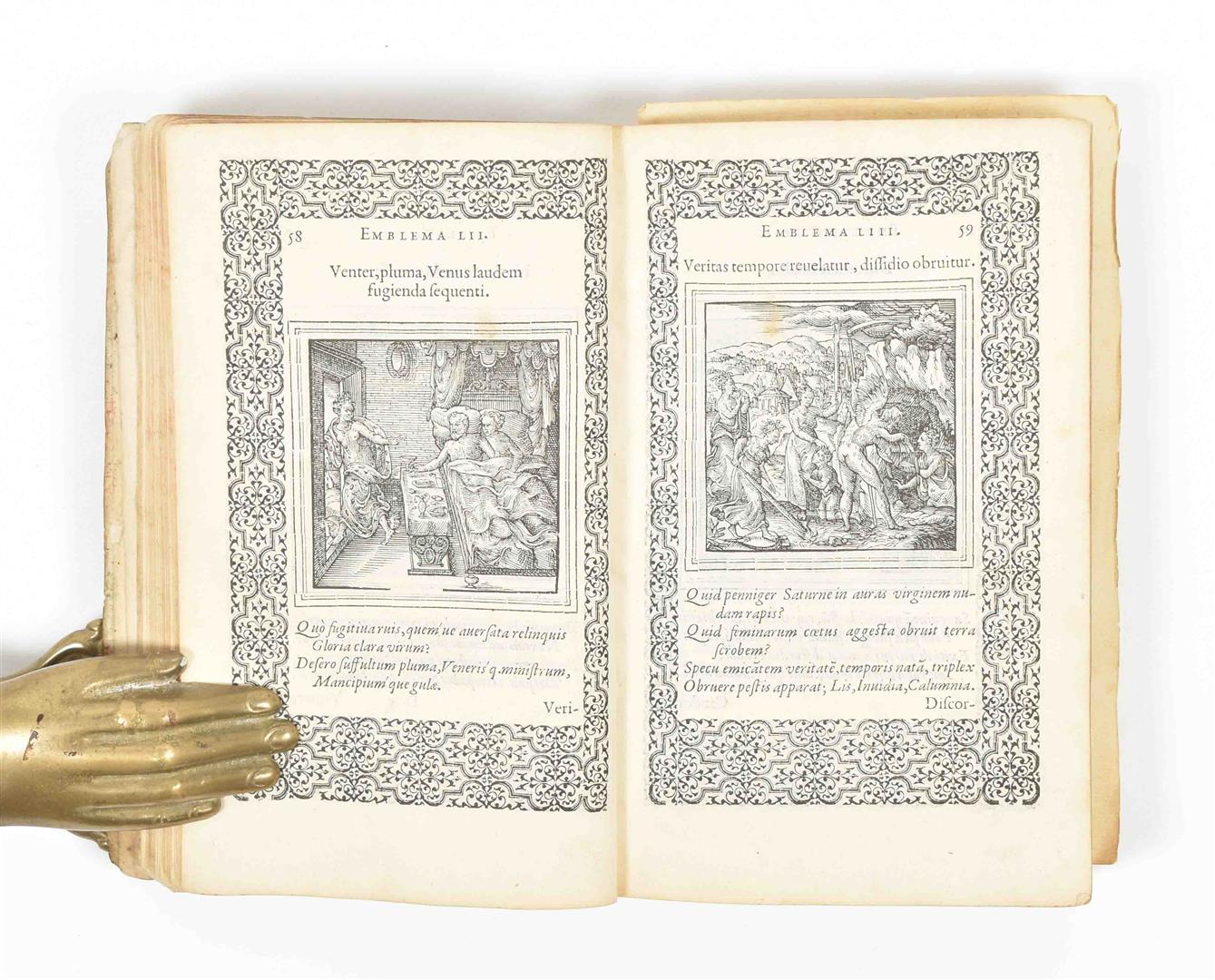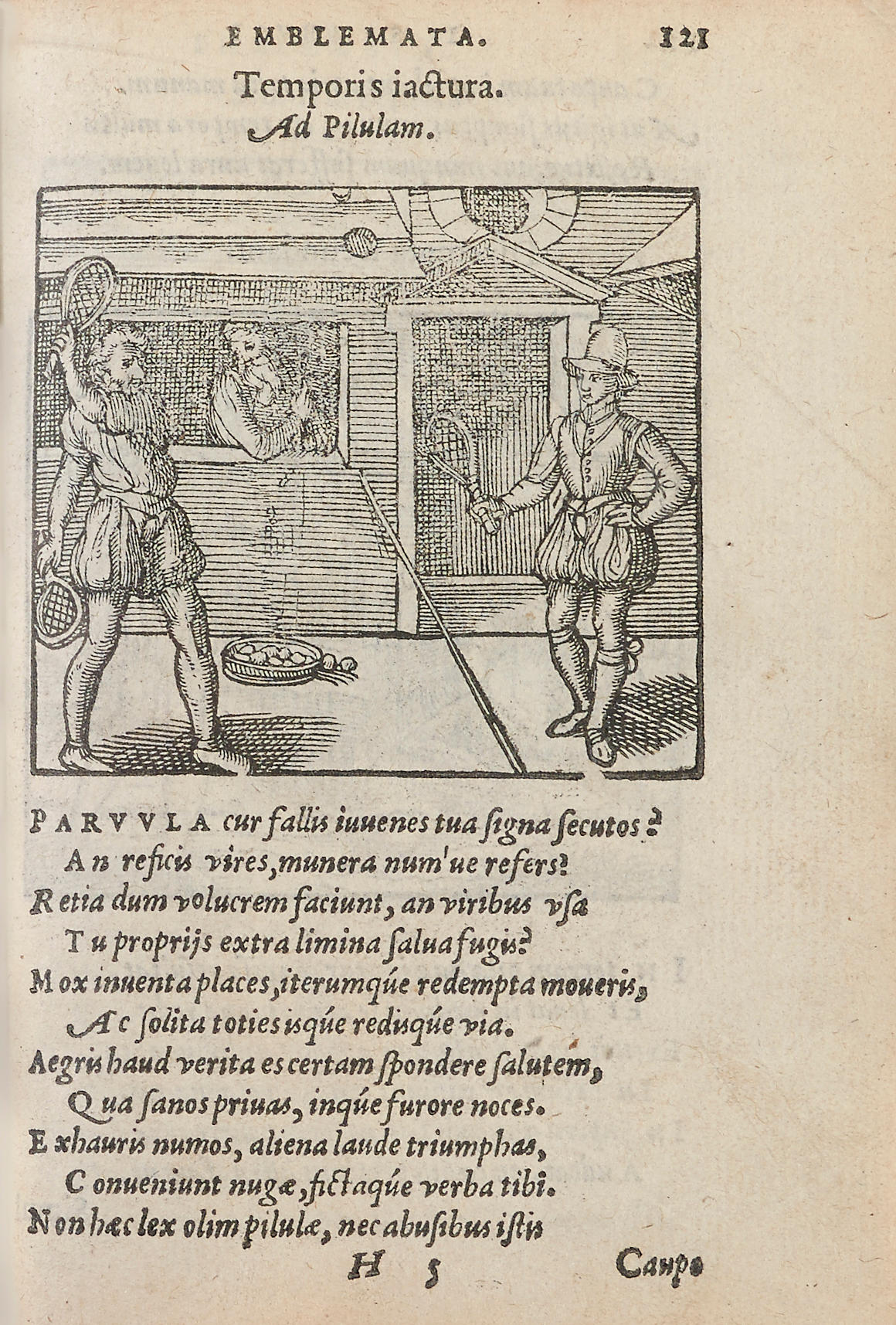SAMBUCUS, Johannes (1531-1584). Emblemata . Antwerp: Christopher Plantin, 8 September 1564. 8° (165 x 105mm), historiated title border, portrait of the author, 166 emblems within varied borders, 46 medals on last four leaves, engraved on wood by A. Nicolai, C. Muller and G. van Kampen after Lucas d'Heere and Pieter Huys (Title soiled and holed at one corner, some soiling of text, waterstaining particularly affecting quires G and P, H2v repaired at inner margin, emblem on H6v with naked figures erased, H6 and H7 extensively repaired, H7v with internal tear to text and slight loss to last line.) Later 19th-century roan-backed boards (extremities worn, front free endpaper lacking).
SAMBUCUS, Johannes (1531-1584). Emblemata . Antwerp: Christopher Plantin, 8 September 1564. 8° (165 x 105mm), historiated title border, portrait of the author, 166 emblems within varied borders, 46 medals on last four leaves, engraved on wood by A. Nicolai, C. Muller and G. van Kampen after Lucas d'Heere and Pieter Huys (Title soiled and holed at one corner, some soiling of text, waterstaining particularly affecting quires G and P, H2v repaired at inner margin, emblem on H6v with naked figures erased, H6 and H7 extensively repaired, H7v with internal tear to text and slight loss to last line.) Later 19th-century roan-backed boards (extremities worn, front free endpaper lacking). FIRST EDITION of at least five. Whitman believed the emblem of a tennis game on p. 133 to be the earliest in a printed book. In fact, the tennis emblem had appeared in Guillaume de la Perrières's Le theatre des bons engins of 1539, and then in the Picta Poesis of Barthélémy Aneau (first edition 1552). Here the emblem is more refined, there is greater form to the rackets and dress of the players, and the tennis balls on the court floor are an important addition. While the net still appears to be a simple rope, two lines of the accompanying poem, 'Temporis iactura' ('A Waste of Time'), draw a comparison between the allure of tennis nets and the more useful nets used in hunting birds. Addressed 'Ad pilulam' ('To the tennis ball'), the poem treats the ball as the deceiver of the young men who waste their time chasing after it. Adams S-218; Brunet V, 104-05; Landwehr Emblem Books 590; Praz p. 148; Whitman p. 176.
SAMBUCUS, Johannes (1531-1584). Emblemata . Antwerp: Christopher Plantin, 8 September 1564. 8° (165 x 105mm), historiated title border, portrait of the author, 166 emblems within varied borders, 46 medals on last four leaves, engraved on wood by A. Nicolai, C. Muller and G. van Kampen after Lucas d'Heere and Pieter Huys (Title soiled and holed at one corner, some soiling of text, waterstaining particularly affecting quires G and P, H2v repaired at inner margin, emblem on H6v with naked figures erased, H6 and H7 extensively repaired, H7v with internal tear to text and slight loss to last line.) Later 19th-century roan-backed boards (extremities worn, front free endpaper lacking).
SAMBUCUS, Johannes (1531-1584). Emblemata . Antwerp: Christopher Plantin, 8 September 1564. 8° (165 x 105mm), historiated title border, portrait of the author, 166 emblems within varied borders, 46 medals on last four leaves, engraved on wood by A. Nicolai, C. Muller and G. van Kampen after Lucas d'Heere and Pieter Huys (Title soiled and holed at one corner, some soiling of text, waterstaining particularly affecting quires G and P, H2v repaired at inner margin, emblem on H6v with naked figures erased, H6 and H7 extensively repaired, H7v with internal tear to text and slight loss to last line.) Later 19th-century roan-backed boards (extremities worn, front free endpaper lacking). FIRST EDITION of at least five. Whitman believed the emblem of a tennis game on p. 133 to be the earliest in a printed book. In fact, the tennis emblem had appeared in Guillaume de la Perrières's Le theatre des bons engins of 1539, and then in the Picta Poesis of Barthélémy Aneau (first edition 1552). Here the emblem is more refined, there is greater form to the rackets and dress of the players, and the tennis balls on the court floor are an important addition. While the net still appears to be a simple rope, two lines of the accompanying poem, 'Temporis iactura' ('A Waste of Time'), draw a comparison between the allure of tennis nets and the more useful nets used in hunting birds. Addressed 'Ad pilulam' ('To the tennis ball'), the poem treats the ball as the deceiver of the young men who waste their time chasing after it. Adams S-218; Brunet V, 104-05; Landwehr Emblem Books 590; Praz p. 148; Whitman p. 176.









Testen Sie LotSearch und seine Premium-Features 7 Tage - ohne Kosten!
Lassen Sie sich automatisch über neue Objekte in kommenden Auktionen benachrichtigen.
Suchauftrag anlegen